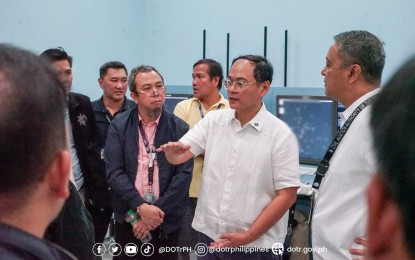MANILA – Acting Transportation Secretary Giovanni Lopez inspected the Air Traffic Management Center (ATMC) of the Civil Aviation Authority of the Philippines (CAAP) to help ensure hassle-free travel for air passengers during Undas (All Saints’ and All Souls’ Days).
The preparations are in line with the President’s order to ensure aviation operations remain efficient and provide hassle-free travel to the public.
During the inspection, Lopez said their goal is to avoid a repeat of the 2023 New Year’s technical glitch that affected several flights to and from the Ninoy Aquino International Airport.
He ordered the CAAP to perform all necessary repairs and upgrades of the ATMC.
“We checked the redundancy, among others. Let’s ensure there won’t be a repeat of the past, so we won’t hassle our passengers beginning Undas until Christmas day and New Year’s Day,” he said.
To date, CAAP has initiated systems redundancy and upgrades in its existing Communications, Navigation, Surveillance/Air Traffic Management (CNS/ATM).
In addition, CAAP has purchased new uninterruptible power supply (UPS) units for its CNS/ATM to prevent unexpected shutdowns.
On Jan. 1, 2023, the CAAP ATMC, which controls and oversees all inbound and outbound flights and overflights within Philippine airspace, went offline due to a power outage, resulting in the loss of communication, radio, radar, and internet services.
The incident disrupted several flights, affecting thousands of passengers at NAIA and other airports nationwide.
Air Traffic Management Center (ATMC)
The Air Traffic Management Center (ATMC) is a modern facility responsible for the strategic management and safe, efficient flow of air traffic within a specific airspace region. It evolved from earlier control tower and radar-based systems to become a centralized hub that uses advanced computer and satellite technology to coordinate aircraft from departure to arrival. Its history is part of the broader development of air traffic control, which became increasingly organized and technologically sophisticated following the rise of commercial aviation in the 20th century.
Civil Aviation Authority of the Philippines (CAAP)
The Civil Aviation Authority of the Philippines (CAAP) is the national regulatory body for civil aviation in the Philippines, established in 2008 to replace the Air Transportation Office (ATO). It was created to address safety concerns and improve the country’s aviation standards after the Philippines was downgraded by international safety audits. The CAAP is responsible for overseeing all aspects of civil aviation, including safety regulations, airport operations, and air navigation services.
Ninoy Aquino International Airport
Ninoy Aquino International Airport (NAIA) is the primary international gateway serving Manila and the Philippines. It was originally named Manila International Airport but was renamed in 1987 in honor of Benigno “Ninoy” Aquino Jr., a senator whose assassination at the airport in 1983 was a pivotal event leading to the People Power Revolution. Today, it is one of the busiest airports in Southeast Asia.
Undas (All Saints’ and All Souls’ Days)
Undas is the traditional Filipino observance of All Saints’ Day (November 1) and All Souls’ Day (November 2), combining Catholic traditions with indigenous ancestor veneration practices. Families travel to cemeteries to clean and decorate the tombs of loved ones, offering prayers, flowers, and candles in remembrance. This multiday commemoration reflects the Philippines’ unique cultural fusion of Spanish colonial religious influences with pre-existing Filipino values of family and respect for ancestors.
Communications, Navigation, Surveillance/Air Traffic Management (CNS/ATM)
CNS/ATM is a modern, global system for managing air traffic that replaced older ground-based radar systems. It integrates satellite-based Communication, Navigation, and Surveillance with advanced Air Traffic Management techniques to create more efficient and safer flight paths. This system was developed to accommodate the growing volume of air traffic and has been implemented worldwide since the late 20th century.






